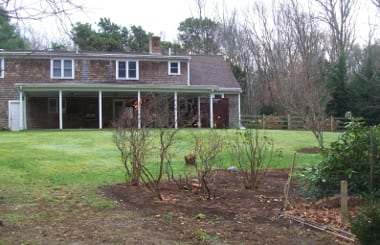by Trevor Smith
A low gurgle emerges from beneath the Mentha aquatica as clear water begins to make its way from the bog downstream between smooth boulders and over gravel. Liquid fingers catch the sun’s rays, bending them and throwing them in every direction. The blooms of iris, hemerocallis, and lobelia bob in the gentle breeze over the bog, where the water collects. The stream rushes over a broken slab of granite in a shimmering sheet adding its high-pitched notes to the chorus of gurgles above as it drops into the pond. Alighting on the edge, a female robin takes a drink, startling a small frog sunning on a warm boulder, while further along sparrows take turns flitting from a Dappled Willow to bathe. The splash of a Frisbee is followed by another splash as a dog wades into the water and momentarily disrupts the serene calm.
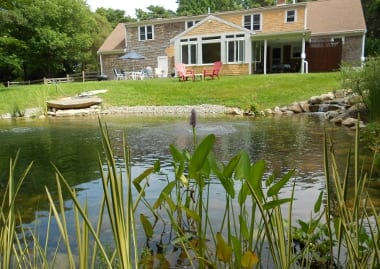
The view across this constructed pond a few months after installation shows steps leading into the pool (left) and a waterfall on a constructed stream (right).
This entire sensory scene takes place at a swimming pond I recently constructed in Sandwich, MA and is the embodiment of residential ecology combining habitat creation and rain harvesting, along with human interaction. It is 100% chemical free, low maintenance and provides year round interest unlike a regular swimming pool. And although a swimming pond costs more than a rubber lined pool, it costs less than a gunite pool of equal size and comes with a tremendous number of additional benefits.
Decide on a Style
When I was first approached to build a natural pool, I had to determine which style best suited the location and appealed to the customer. There are three styles of swimming ponds: natural, clay bottom, and rubber lined.
- The natural pond is just that – a spring or stream fed area that is adapted either through dredging or through landscape adaptation, such as by creating an entry point or adding a dock to be user friendly.
- A clay-lined pond is constructed by excavating the pond and packing the bottom with clay to prevent leakage. The pond is then landscaped with stone and plants to naturalize it.
- The rubber lined pond is a large version of a koi pond. The pond is excavated lined with a rubber pond liner which is covered with boulders and gravel to mask the liner. Then like the clay pond it is landscaped to naturalize it.
All of these ponds are primarily filtered by the plants to keep the water clean; the clay and rubber lined ponds also use pumps and filters to aid in additional water filtration. The pond I chose to build for my client is rubber lined and has a 12 foot by 12 foot bog, a 40 foot stream, and two skimmers, all of which provide filtration and aeration and ensure proper water circulation.
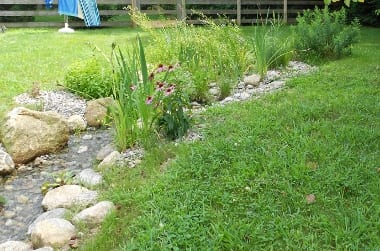
In this design, water flows through a bog environment (top right) and into a 40 foot stream before dropping into the pond below.
Keys to Construction
There are five major keys to successful pond construction: location, hardware, water flow, circulation and filtration. The first key, location, is elementary; you want to situate your pond close enough to the house so that it is accessible and oriented for the best possible viewing. It is also best to locate the pond such that the majority of it receives full sun. Full sun is good for plant options, but also ensures that the water will not be too cold. Having full sun requires situating the pond away from trees. This not only increases the light the pond receives, but reduces maintenance in the fall. This does not mean, however, finding a barren area. The idea is to create a natural looking pond, and in nature trees grow near ponds. The pond, in this example, is surrounded by oaks and pines 50 or so feet away, and the edge is planted with shrubs.
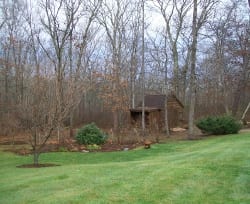
Before construction, the site for the pond, situated near a wooded area, held a vegetable garden and perennial plants.
The hardware you choose is very important for the flow of the water, but also for the environment. This pond utilizes four high efficiency pumps. There is a one horsepower pump that draws from the bottom and pushes the water up to the bog, two smaller pumps that draw water through the skimmers, and finally an air pump that pumps air down to the bottom of the pond. It is important to choose durable high efficiency hardware on a project this size to help increase the energy efficiency of the system and keep the environmental footprint as small as possible.
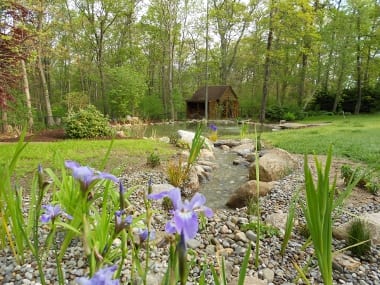
Water drawn from the bottom of the pond is pushed to the top of the bog zone where it seeps through the root zone of plantings before flowing into the adjoining stream.
Controlling Water Flow and Circulation
Nobody wants to float the dog days of summer away in a pool of mush, nor do they want to towel off smelling like a vernal pool or retention pond. This is why water flow and circulation are paramount considerations in swimming pond construction. In this pond, as described above, the large pump pushes water to the bog. The water then passes through the root zone of the plants before exiting to the stream. The plants along the stream aid in filtration, and the water is oxygenated as it spills over the rocks and falls. While a stream and bog are not mandatory components to proper pond filtration and circulation, they do make the process much easier and more efficient.
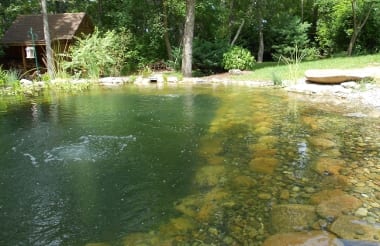
An aerator, visible at left, helps prevent anaerobic conditions in the pond, and skimmers (at the far end of the pond, opposite the stream) assist with filtration.
The skimmers draw water from the ponds surface reducing surface debris and run it through ultraviolet (UV) tubes before returning the water to the pond via pipe beneath the root zones of the marginal plants. The UV lights are turned on during the hottest months or during times of high usage to help equalize the bacteria load, aiding in algae control. Lastly, the aerator pumps air to the bottom of the pond. This prevents anaerobic conditions within the depths of the pond by pushing that water to the surface.
Figuring Out Filtration
Filtration ties in closely to water flow and circulation. This pond is filtered both biologically and mechanically. The biological filtration is handled by both the plants in the pond and through beneficial bacteria which is added weekly to the pond and is essentially the only additive to a holistic pond system. The planting for the pond was designed for both beauty and functionality. All of the plants in the pond I developed for my client have either a bloom and/or foliar interest throughout the year and are planted at varying depths to maximize the zones of filtration. In both the bog and stream, marginal and terrestrial plants that don’t mind “wet feet” were used such as iris, hemerocallis, lobelia and marginal mint as well a Horse Tail Rush and different sedges. Along the edges of the pond, deeper marginal plants were used such a Pickerel Rush, Sweet Flag, and Golden Club, and at the two foot depth water lilies were planted to sprawl along the back edge of the pond. Though all the plants take up nutrients through the growing season, they draw the most when in bloom or at the peak of their growing cycle. In choosing plants for a pond, it is important to stagger the plants according to their peak to achieve a constant nutrient draw.
The bacterial component of the filtration process takes place in the gravel substrate of the pond and within the skimmer filters. As previously mentioned, beneficial bacteria is added to the pond weekly. These bacteria colonize in the gravel and in the filter mat of the skimmer and help break down excess nutrients in the water. The colonized bacteria aid in water clarity while reducing organic sludge, maintaining healthy nitrogen and ammonia levels, and improving dissolved oxygen levels.
The mechanical filtration is simple and handled by the skimmers. The skimmers are positioned on either edge of the pond. The pumps draw the water and whatever is floating on it such as leaves into the skimmer. Here it passes through a basket that removes large debris and then through a mat that removes silts and smaller debris. Using mechanical filtration helps reduce the amount of debris that sinks to the bottom to decompose and add excess nutrients to the water, leading to algae blooms. Though the process and methods are simple, they are vital to maintain a healthy pond for plants wildlife and people.
Counting the Benefits
The one additional component of this pond that takes it over the top environmentally is the addition of rain water capture. There are two rain water filters attached to the gutters of the house which filter and channel three quarters of the rainwater from the roof at the back of the house to the bog. In this application there are two major benefits, topping off the pond and reducing runoff from the lawn. At the height of the summer, a pond can lose two inches of water a week due to evaporation.
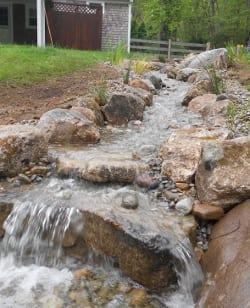
Diverting rain water from the house downspouts into the bog area of the pond installation helps maintain the water level in the pond and also reduces runoff from the lawn.
By capturing the rain water from the roof, we reduce the number of times the homeowner needs to top of the pond to maintain the optimal water level. The second benefit, reducing storm water runoff from the lawn, also reduces the amount of debris, silt, and toxins the storm water would otherwise deposit in the pond. The filter system I chose for this project is the Atlantic Clean Rain Ultra Downspout Diverter. This system is designed to allow the first inch of rain water (which carries the most toxins from the roof) to pass through a filter and exit through the gutter system normally. After that first inch, a mechanism in the system switches to divert the water into the bog so that the pond receives only clean, filtered rain water.
Selling a Natural Pond
If having a low maintenance water feature that is safe for people and good for planet and that attracts countless birds and boasts a rainbow of colorful blooms isn’t enough to convince a prospective client to install a swimming pond, then the seasonal enjoyment will. A normal swimming pool in New England provides a maximum of five months of enjoyment. When it rains or it is too cold to use, a traditional swimming pool is a static thing and related chores are a constant item on the weekend to-do list. Fall means finding the time to winterize and pull on the cover that will be your view for the next seven months.
In contrast, with a swimming pond, you can spend warm spring days by the water’s edge with a cup of coffee and a book listening to the falls and the birds, watching your plants awake from winter’s slumber. Rainy days still provide a majestic view until the weather clears and warm summer months begin. In the autumn as in the springtime, the natural pond owner can spend time by the water’s edge watching the wildlife and communing with nature. When winter sets in and the world becomes a stark etching of summer’s carnival brilliance, a swimming pond can be used for skating or viewed through the windowpane speaking to our naturalist soul like a Robert Frost poem.
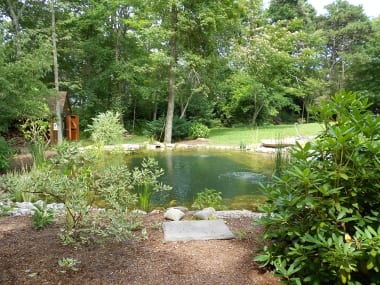
Plants from the original perennial garden, including dogwood and rhododendron, were relocated around the swimming pool and provide an inviting backdrop.
Seated on a large rock feet submerged in the cool clear water the sun’s rays warm your face as dragonflies dart about, you may notice a colorful fish just beneath the surface of the calm water before it retreats to the depths. You rise and leap off the rock, and as your head emerges from the water, rivulets streaming down your face, you feel one with nature, your soul refreshed basking in your private paradise.
About the Author
Trevor Smith is the owner of Land Escapes, a full service ecological landscaping company in the Boston area that specializes in Garden Design, Eco-Rain Recovery, Water Features, and Living Wall Installations. Trevor is also the Vice President of the Ecological Landscape Alliance. You can reach Trevor through his website: www.everydaygetaway.com.


